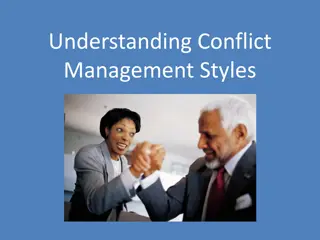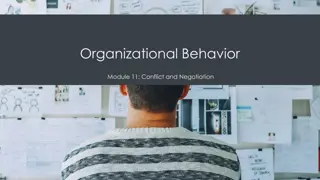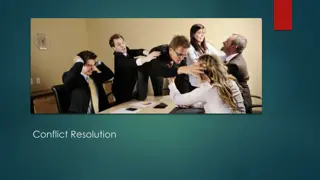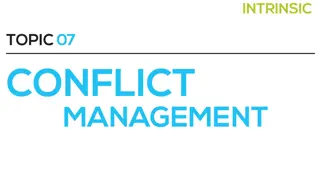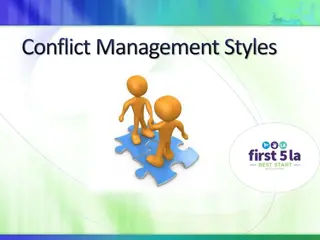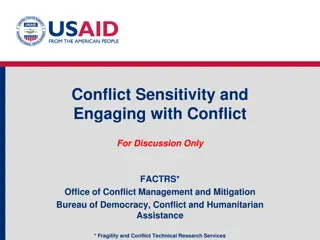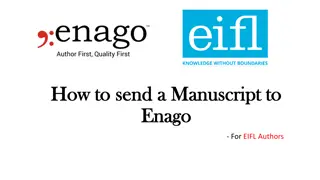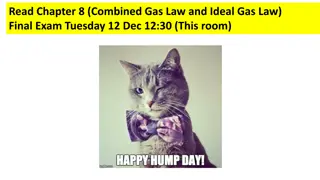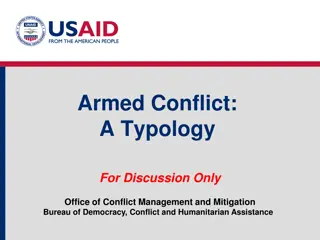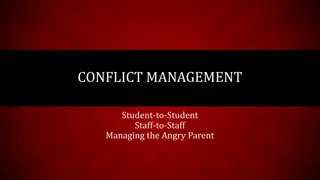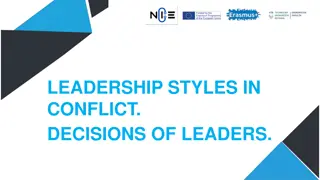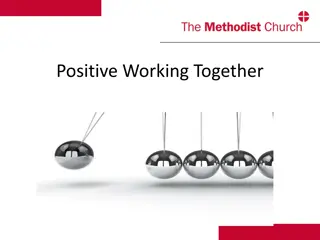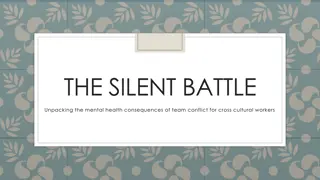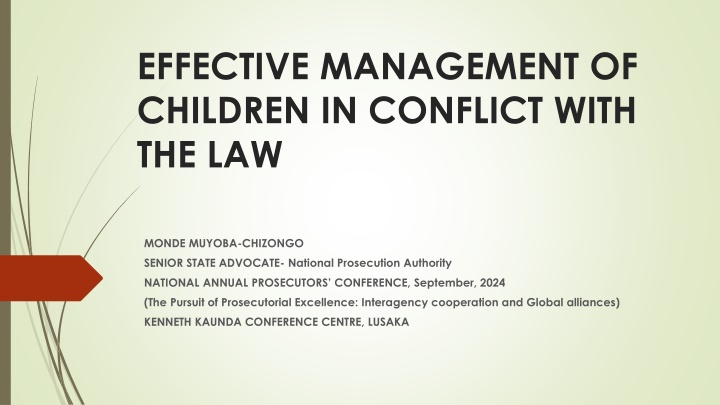
Management of Children in Conflict with the Law: Key Components and Best Practices
Explore effective management strategies for children in conflict with the law, focusing on the role of prosecution, best interest of the child, child-first approach, and rights during the investigation stage. Learn about the importance of balancing rehabilitation and accountability while safeguarding children's rights and well-being.
Download Presentation

Please find below an Image/Link to download the presentation.
The content on the website is provided AS IS for your information and personal use only. It may not be sold, licensed, or shared on other websites without obtaining consent from the author. If you encounter any issues during the download, it is possible that the publisher has removed the file from their server.
You are allowed to download the files provided on this website for personal or commercial use, subject to the condition that they are used lawfully. All files are the property of their respective owners.
The content on the website is provided AS IS for your information and personal use only. It may not be sold, licensed, or shared on other websites without obtaining consent from the author.
E N D
Presentation Transcript
EFFECTIVE MANAGEMENT OF CHILDREN IN CONFLICT WITH THE LAW MONDE MUYOBA-CHIZONGO SENIOR STATE ADVOCATE- National Prosecution Authority NATIONAL ANNUAL PROSECUTORS CONFERENCE, September, 2024 (The Pursuit of Prosecutorial Excellence: Interagency cooperation and Global alliances) KENNETH KAUNDA CONFERENCE CENTRE, LUSAKA
KEY COMPONENTS OF THE ACT CCA CHILDREN IN CONFLICT WITH THE LAW CHILD VICTIMS AND WITNESSES CONSOLIDATION OF LAWS RELATING TO CHILDREN DOMESTICATION OF INTERNATIONAL INSTRUMENTS. CRC REPEAL OF ACTS
ROLE OF PROSECUTION IN THE MANAGEMENT OF CHILDREN IN CONFLICT WITH THE LAW Effective management of children in conflict with the law involves balancing the goals of rehabilitation and accountability while safeguarding the rights and well- being of the child. All decisions made by public and private bodies affecting a child must always take into account the best interest of the child. This includes decision made by the prosecution to either prosecute or not or to divert or not. Section 3 of the Children s Code Act
BEST INTEREST OF THE CHILD AND RIGHTS. 3. (1) A child s best interest is the primary consideration in a matter or action concerning the child, whether undertaken by a public or private body.
CHILD FIRST APPROACH Prioritises children child justice system as children first and if a child contravened any law, as an second. viewing within The primary focus of this approach is to prevent traumatisation children in conflict with the promote for children conflict with the law, and exhibit a clear commitment developing interventions avoid preventable prosecution criminalisation children. the re- for has law, offender diversion in to to and of
RIGHTS OF CHILDREN IN CONFLICT WITH THE LAW (INVESTIGATION STAGE) Right to privacy Protection of identity from exposure by the media or any other publication Right to remain silent Right to be interviewed in the presence of the parent, guardian, child welfare inspector, legal representative, close relative of the child or person having parental responsibility of the child.
RIGHTS OF CHILDREN IN CONFLICT WITH THE LAW (COURT PROCESS/PROSECUTION Right to legal representation Right to have proceedings to be heard in camera Right to privacy Right to give sworn evidence Right to give unsworn evidence Right to remain silent Right to call any available witnesses have the matter determined without delay; not be compelled to give testimony or to confess guilt;
MULTI-DISCIPLINARY APPROACH Judiciary Law Social welfare Departm ent enforcem ent agency CHILDREN prosecution
MULTI-DISCIPLINARY APPROACH CONT D Zambia Correctional Service Legal Aid Board Diversion Service Providers (CSOs and NGOS Ministry of Health
There are two ways in which the NPA manages children in conflict with the law
Prosecutors consider diversion as a measure of first resort. Diversion focuses on addressing the underlying causes of delinquent preventing re-offending.. should always When determining whether a case is suitable for diversion , various factors are determine the suitability of the case for diversion. These factors apply on a case by case basis. considered to behavior and Once a decision to divert is made, a prosecutor must ensure that all stakeholders communicated to and dates set to commence the diversion process. At the end of the process, a diversion Implementation must be prepared by a child welfare inspector. involved are A prosecutor must establish that all four conditions are met before proceeding to divert. plan
FACTORS TO DETERMINE BEFORE ONE CAN DIVERT- SECTION 58 (3) OF THE CCA the nature and circumstances of the offence; the degree of harm caused by the child; the culpability of the child; the extent of the child s involvement in the offence; the child s age and developmental needs; whether the child is a repeat offender; whether the child committed the offence with an adult; the extent of remorse of the child; the child s cooperation with the relevant authorities; the child s vulnerability;
CONDITIONS FOR DIVERSION- section 59 of the CCA There is a likelihood of a prima facie case against the child; The child acknowledges responsibility for the offence; The child and the child s parent, guardian or person having parental responsibility for the child consents to the nature, content and duration of a diversion option; and The child and the child s parent, guardian or person having parental responsibility for the child understand the consequences of a failure to comply with a diversion option as specified under section 60(4
DIVERSION OPTIONS- Section 58(2) an informal reprimand by a law enforcement officer; a formal and recorded caution made by a law enforcement officer in the presence of a child s parent, guardian, close relative of the child or person having parental responsibility for the child; taking the child through a diversion programme; mediation; family group conferencing; or restitution.
Prosecution/Court Process Prosecutors must not always push for trial. Where applicable, plea bargaining is preferred. This allows for the parties to agree on the appropriate measure the child welfare inspector may recommend to the court. This also reduces the child s interaction with the court thereby reducing re-traumatisation of the child . Liaise with the legal representative of the child to discuss possibility of the child pleading guilty. Where trial is opted, prosecutors to ensure that all relevant witnesses are prepared in time and appear before court on the dates agreed on for trial. Avoid unnecessary adjournments. Plea of guilty Plea bargaining trial
To effectively manage a child in conflict with the law during trial, Prosecutors should ensure the following safeguards provided by the Children s Code Act are adhered to: presence of a Child Welfare Inspector who will cater for the psycho-social and physical well-being of the child. Court proceeding CANNOT proceed without the presence of a child welfare inspector. the child has legal representation. Section 72 (2) (3) (4) (5) of the CCA the Court is set up in a child friendly manner (no uniformed officers, no fire arms and handcuff, wearing of court regalia.)
Sittings of the juvenile court or Childrens Court be in a different building or room from where other sittings of other courts are held, or at different times or dates from those on which sittings of other courts are held. the privacy of the child is respected at all stages. a child with a disability is given special care and is treated with the same dignity as a child without a disability. that matters are dealt with without delay.
BAIL- SECTION 73(2) OF THE CCA A child in conflict with the law is entitled to apply for bail. All offences are bailable for children in conflict with the law. The Court is mandated to inquire into the matter and determine whether releasing a child on bail may be a danger to that child or the community before granting bail. Your role as a prosecutor during bail applications is to assist the court where possible, by providing the court with information on whether releasing the child would pose a danger to the child or the community. This can be done by a placing a law enforcement officer on stand or having the law enforcement officer swear an affidavit in opposition of a bail application. Where a prosecutor notices that the child s lawyer does not apply for bail on behalf of the child, remind that lawyer to make a bail application.
ROLE OF A PROSECUTOR WHEN PASSING COURT ORDERS Duty to inform the court if the child has been in conflict with the law before. This helps the court with passing an appropriate order. Prosecutors must also inform the court any previous methods used for the rehabilitation of the child and the response to that method. Indicate to the court any aggravating circumstance of the case. Where a plea agreement was entered, liaise with the child welfare inspector managing the child and agree on the recommended order for the child in conflict with the law.
CHALLENGES IN THE MANAGEMENT OF CHILDREN IN CONFLICT WITH THE LAW Cultural and societal attitudes societal attitudes towards children in conflict with the law is punitive and thus making it difficult for prosecutors to make to decision to divert Inadequate resources- NPA facilitates diversion of children however, there are no resources allocated to this. Inconsistent application of child justice principles Inadequate staffing of actors in the child justice system
Lack of accredited diversion service providers and comprehensive diversion programmes Inadequate assessment of children (social Welfare reports) attributed to inadequate child welfare inspectors Different interpretation of provisions of the Children s Code Act by the courts of law. E.g. the definition of the age of child by the courts THE people V James Mwanza and 9 others. The People v Angel Mulenga and Danny Chileshe Age determination not done at earliest point thereby causing delays in the determination of matters in the courts of law.
High rate of recidivism attributed to the failure to deal with the underlying cause of the behaviour exhibited by a child. The People v Windy Likolo-. Inadequate methods to manage the behaviour of children who commit heinous crimes ) Abraham Phiri v The People Delay in the conclusion of the cases. Required to conclude a case in 6 months Actors not specifically trained in child justice matters
THE END CHILD FIRST APPROACH


